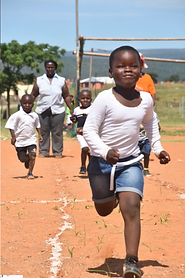Lelethu [It's Ours]
Ubunye's Vision for 2021-2026
Where Communities Lead
in pursuing Sustainable Development that builds Resilience to Climate Change
Communities Lead
Communities are central to the planning, implementation and evaluation of programmes. They manage programmes with Ubunye through the Community Advisory board and Programme Working Groups
Community leadership is in-built into the structure of Ubunye. All our programmes include both community members and staff in Programme Working Groups. Their role is to identify and prioritise what projects Ubunye will focus on, then guide implementation, monitoring and evaluation.
Support Sustainable Development
All Ubunye’s programmes are centred on the Sustainable Development Goals. With communities, Ubunye works to ensure that all programme activities contribute to the longevity and vitality of life in these rural areas.
Our programmes are linked to United Nations Sustainable Development Goals (SDGs). Each programme is monitored and evaluated using the same Sustainable Development Goal indicators - contributing to the global endeavour.
Resilience to Climate Change
Running through all Ubunye’s Programmes is managing and mitigating the challenge of climate change. Each activity considers and acts against potential negative impact on the environment
Together, Ubunye builds ‘green’ businesses, fosters knowledge and care of the environment among youth and ensures a focus on healthy living of all community members.
Context & People

Ubunye works with communities in the
Ngqushwa and Makana Muncipalities of
South Africa’s Eastern Cape province
Ubunye Foundation works alongside communities in Nqgushwa Municipality in the Eastern Cape. Nqushwa is bounded by the Great Fish River to the East and the Indian Ocean to the South and comes under Amathole District.
Ubunye started working with communities in the Ndwayana village area in 2002, supporting women who wanted to set up local childcare facilities. Since then Ubunye has grown into a community partnership with rural communities covering 5 wards (Wards 6,7,8, 9 and 10), over 45 ECD centres, more than 80 savings/livelihoods groups and an MOU with the Department of Health centering on community health in 5 Primary Health Care clinics.
Ubunye also works with communities in Fort Brown village of neighbouring Makana Municipality, Sarah Baartman District.


'Leaky Bucket' Financial planning tool
Based on indicators around health , education, living standards and economic activitiy, 12.7% of people in the Eastern Cape are classifeid as living in poverty (878,000 people). The intensity of that poverty is experienced more by people in this province that any other in South Africa (StatsSA 2019)
In Ngqushwa, with a population of around 64,000 people, youth (15-34 years) unemployment was 64.1%, putting it in the top 6 municipalities with rates over 50% in the country (StatsSA Community Census 2016). The institute of Race Relations using a comfort/deprivation index rated Ngqushwa as the 2nd poorest Municipality in South Africa with 90.2% of households earning less than R1600 per month (IRR 2016).
Focus for Sinako
(Savings & Livelihoods)
Focus for Isisekhelo
(Education for Life)
For youth aged between 15-17 years the average annual income only reaches R2 400. 10% of these youth are head of households. Although nearly all children do go to school at some time between 5-17 years, only 59% achieve Grade 9 and a minority of them, 26.7% reach matric. For younger children, education facilities are extremely limited. Recent figures show that over a third of children under 5 years (126,342 children) are unable to access any ECD education in Amatole District (DSD, 2018).
Glenmore Educare Centre learners



Land close to Ndwayana village
Focus for Sinako
(Green Business)
Ngqushwa Municipality have been devastated by a 5-year long drought which has left all the communities dependent on intermittent water supplied by the Municipality via stand pipes and more recently via water tankers. Grazing for domestic cattle, donkeys and even for pigs and goats has mostly been depleted as the land has dried out and land erosion has taken over. As livelihoods and even subsistence farming has become more difficult migration towards urban centres: Makhanda, Port Elizabeth and into the Western Cape has quadrupled leaving only the elderly and the very young behind.
Focus for Masiphile (Health & Wellness)
HIV and TB have devastated communities in South Africa. An estimated 13.5% of the total population, over 7.97 million people are living with HIV. A fifth of South Africa women aged between 15-49 years are HIV positive (StatsSA Mid Year Population estimate 2019). From 2010, the prevalence of HIV has continued to rise in the Eastern Cape with 13.04% of the popuation now living with HIV. 61% of those diagnosed with HIV are on treatment and only 48.4% are taking their medication regularly (MacDonell,S. Low, M. 2019)
It is estimated that around 80% of people in South Africa are infected with TB. In 2018, TB remained the leading casue of death with a total of 63,000 people dying of TB, 42 000 of them were HIV positive. In 2015, Sarah Baartman district in the Eastern Cape had the highest TB incidence for the entire country (TBFact.org)

Field Officer Luleka Kondlo and community member, Nomfuso Mashini presenting Ubunye's Health Programme at the Durban AIDS Conference
The Ubunye Team
Asanda Nkone
Ikamva Lolutsha (Young Futures) (Fort Brown)
Programme Field Officer

Nomfundiso Basi
Ikamva Lolutsha (Young Futures) (Fort Brown)
Programme Field Officer
















